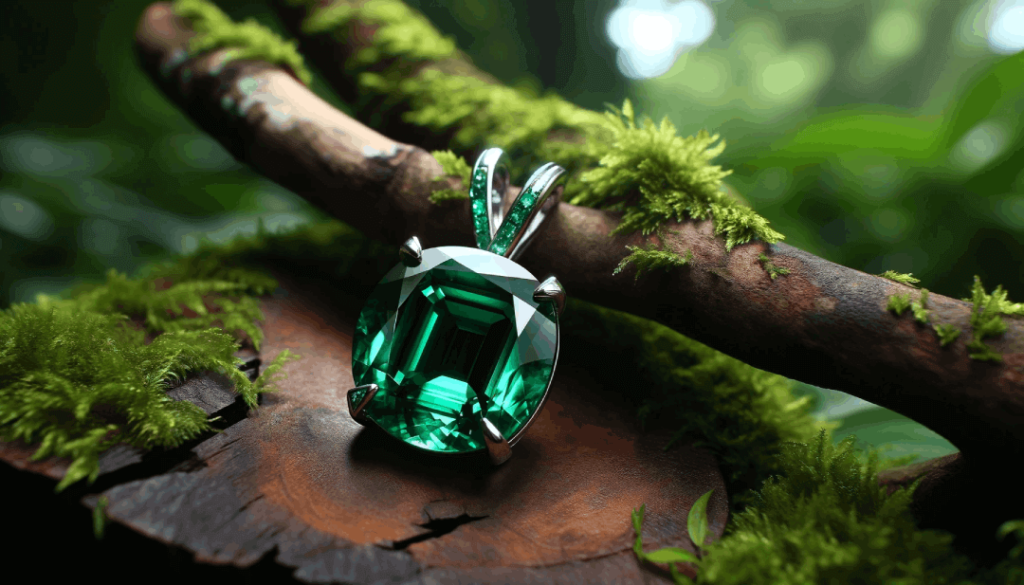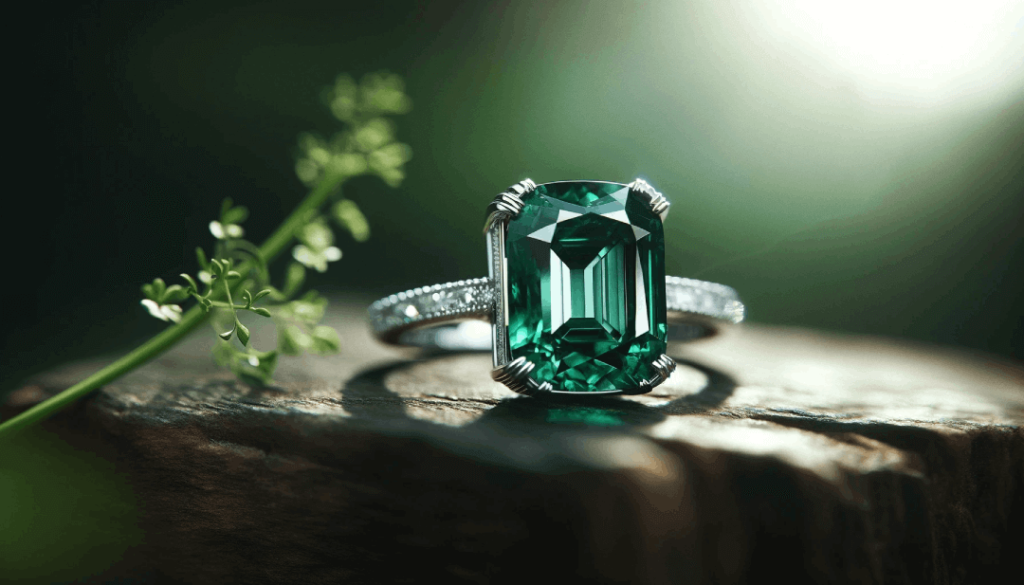Emeralds are gemstones renowned for their lush and vivid green hue. These gemstones have a storied history and a significant place in the world of jewelry and geology.
History and Origin of Emerald
Emeralds have been cherished for their striking green color since antiquity. They have been found in various parts of the world, including ancient mines in Egypt, where Cleopatra herself was known to have a fondness for these gems. Their history includes being revered by cultures like the Incas and Aztecs, who considered them sacred. Emeralds are also associated with myth and legend, such as being the gemstone of the goddess Venus in Roman mythology. These gemstones have a rich heritage and have been valued for their beauty and symbolism throughout the ages.
Is Emerald a Birthstone?
Yes, emerald is indeed associated with birthstones. It is considered the birthstone for May. Many people believe that wearing an emerald during their birth month can bring them good fortune and protection. It adds a personal touch to jewelry and makes it a meaningful gift for those born in May or anyone who appreciates the beauty of emeralds.
Appearance and Structure
Emeralds possess distinctive characteristics that make them stand out in the world of gemstones.
- Color: Emeralds are renowned for their lush green color, which can range from a light, delicate green to a deep and intense hue. The finest emeralds exhibit a rich, vibrant green that is often described as “emerald green.”
- Transparency: Emeralds are typically transparent to translucent. The most valuable emeralds are highly transparent, allowing light to pass through and showcase their vivid green color.
- Crystal Structure: Emeralds belong to the beryl family of minerals and have a hexagonal crystal structure. This structure can result in well-formed hexagonal prisms, which are often used for cutting emeralds into gemstones.
- Inclusions: Unlike some gemstones, emeralds often contain inclusions or internal imperfections. These inclusions sometimes referred to as “jardin” (French for garden), are often seen as a characteristic of natural emeralds and can help distinguish them from synthetic or treated counterparts.
- Hardness: Emeralds have a hardness of 7.5 to 8 on the Mohs scale, making them relatively durable for jewelry use but still requiring care to prevent damage.
- Cleavage: Emeralds have poor cleavage, which means they are less prone to breaking along specific planes compared to some other gemstones.
- Luster: When well-cut and polished, emeralds exhibit a vitreous to glassy luster that enhances their beauty.

Healing Properties of Emerald
Emeralds, with their green allure, have long been associated with a range of healing properties. Beyond their stunning aesthetics, these gems are believed to possess unique qualities that can benefit individuals on physical, emotional, and spiritual levels.
Emotional Healing
Emeralds are believed to foster compassion, empathy, and a sense of inner peace. Emotionally, emeralds are associated with promoting emotional balance and helping individuals overcome feelings of jealousy, insecurity, and negativity. Wearing emerald jewelry or meditating with emerald crystals is often recommended to harness these emotional healing properties.
Spiritual Healing
Emeralds have a deep connection to spirituality and are believed to enhance spiritual insight and growth. They are thought to stimulate the heart chakra, fostering a sense of love and compassion, both for oneself and for others. This connection to the heart chakra may facilitate inner healing and spiritual awakening, allowing individuals to explore their deeper spiritual selves.
The Symbolic Power of Emerald
Gemstones possess a unique and timeless quality that often transcends words. Their inherent characteristics, such as color, rarity, and symbolism, can speak volumes as symbols of various emotions, relationships, and aspirations. Beyond their aesthetic allure, gemstones can convey deep sentiments, making them powerful tools for expressing love, friendship, and success. The choice of a specific gemstone can serve as a meaningful gesture, allowing individuals to communicate their intentions and feelings in a way that words alone may struggle to achieve.
Bond of Friendship
Gemstones, like emeralds, can serve as beautiful tokens of friendship. The rich green color of emeralds symbolizes growth and renewal, qualities that are often cherished in close relationships. Gifting an emerald to a friend can signify the desire for the friendship to flourish and thrive, just as the gemstone’s color suggests. It can also be a reminder of the enduring nature of true friendship, a bond that remains strong even in challenging times.
- Birthday Surprise: Presenting an emerald necklace to a close friend on their birthday, explaining that it represents the evergreen nature of your friendship and your wishes for their continued growth.
- Support in Tough Times: Give an emerald bracelet to a friend who is going through a difficult period as a symbol of your unwavering support and the hope for better days ahead.
- Graduation Gift: Gifting an emerald-studded ring to a friend upon their graduation, signifying the growth and achievement they’ve experienced and celebrating their future success.
Language of Love
When it comes to expressing love and romance, gemstones like emeralds can be incredibly meaningful. The vivid green of emeralds represents the lushness of love, while their rarity underscores the uniqueness of each relationship. Offering an emerald as a gift to someone you love can convey your deep affection, commitment, and appreciation for their presence in your life.

- Anniversary Surprise: Presenting an emerald pendant to your partner on your anniversary, symbolizing the enduring and evergreen love you share.
- Proposal Moment: Use an emerald engagement ring to propose, signifying the rarity and preciousness of the love you wish to nurture for a lifetime.
- Special Date Gift: Give emerald earrings as a surprise gift on a special date night to express your affection and create a lasting memory.
Achieving Success
Emeralds are often associated with qualities like harmony, balance, and growth. When it comes to achieving success and life goals, wearing emerald jewelry can serve as a reminder of your aspirations. The gemstone’s lush green color can symbolize the abundance and growth you hope to achieve in your career and personal development.
- Job Interview: Wearing an emerald tiepin or brooch to a job interview to convey a sense of confidence, balance, and growth potential.
- Entrepreneurial Ventures: Incorporating emerald jewelry into your professional attire when launching a new business, reflecting your aspirations for growth and prosperity.
- Milestone Achievement: Marking a significant career milestone, such as a promotion, by gifting yourself an emerald ring to celebrate your accomplishments and set new goals.
Value of Emeralds in Jewelry
Emeralds hold a special place in the world of jewelry due to their beauty and symbolic significance. When emeralds are used in jewelry, they become more than just adornments; they become tangible expressions of love, friendship, and personal aspirations. Each piece of emerald jewelry carries with it the rich history and symbolism associated with this gemstone, adding an extra layer of meaning and value to the wearer. Whether worn as an heirloom, given as a gift, or chosen as a personal accessory, emerald jewelry embodies a connection to nature, history, and the deepest emotions of the heart.
Care and Maintainance
Caring for and maintaining an emerald is crucial to preserve its beauty and ensure its longevity. Emeralds, like all gemstones, can be sensitive to wear, environmental factors, and chemicals. Proper care not only retains their vibrant green color but also maintains their value and sentimental significance. Regular cleaning, charging, and careful storage can help you enjoy your emerald for generations to come.
Cleaning and Charging
- Gentle Cleaning: Use a soft, lint-free cloth or a jewelry cleaning brush to remove dust and surface dirt from your emerald jewelry. Avoid abrasive materials that can scratch the gemstone.
- Mild Soapy Bath: For a deeper clean, create a solution of warm water and mild, phosphate-free soap. Soak the emerald jewelry for a few minutes, gently scrubbing with a soft brush. Rinse thoroughly with clean water.
- Drying: Pat the emerald jewelry dry with a soft cloth and ensure it is completely dry before storing it. Avoid exposing emeralds to extreme heat, which can lead to fractures.
- Charging in Moonlight: Some believe that emeralds can benefit from charging in moonlight. Place your emerald jewelry under a full moon for a few hours to refresh its energy, as per metaphysical practices.
Storage and Handling
- Separate Storage: Store your emerald jewelry separately from other jewelry to prevent scratching. You can use soft pouches or jewelry boxes with individual compartments.
- Avoid Direct Sunlight: Keep emeralds away from prolonged exposure to direct sunlight, as excessive heat can cause them to become brittle and lose their color.
- Gentle Handling: Handle emeralds with care to avoid impacts or knocks that can lead to chipping or damage. Avoid contact with chemicals, including household cleaners.
- Regular Inspections: Periodically inspect your emerald jewelry for loose settings or signs of wear. Promptly address any issues to prevent further damage.
Altar with Emerald

Emeralds, known for their lush green color, are believed to symbolize love, renewal, and growth. When combined with other gemstones, the intention is to create a balanced and harmonious energy mix. These combinations are often arranged on what is called an “altar,” a sacred or ceremonial space that holds spiritual significance. Altars serve as focal points for meditation, prayer, or rituals, where the synergy of gemstones can amplify intentions, promote healing, or enhance spiritual connections. This practice blends both the aesthetic beauty of gemstones and the metaphysical qualities they are believed to possess, creating a meaningful and powerful synergy for those who use them.
- Amethyst (or Lepidolite): Amethyst, known for its spiritual properties, pairs well with emerald to enhance spiritual growth and insight. Together, they create a harmonious blend of spiritual energies. Lepidolite shares similar spiritual attributes, aiding in meditation and inner peace. It serves as an excellent alternative to promote spiritual development.
- Citrine (or Yellow Aventurine): Citrine, associated with abundance and prosperity, can be combined with emerald to amplify success and wealth-attracting energies. Together, they create a harmonious blend of growth and prosperity. Yellow Aventurine shares citrine’s abundance attributes, making it an excellent alternative to attract prosperity and financial well-being.
- Moonstone (or Labradorite): Moonstone, representing intuition and emotional balance, pairs well with emerald to enhance emotional harmony and insight. Together, they create a balanced yin-yang energy. Labradorite also enhances intuition and offers protection. It serves as a choice for emotional and spiritual growth.
- Rose Quartz (or Rhodonite): Rose quartz, the “stone of love,” complements emerald’s ability to foster compassion and deep emotional connections. Together, they enhance feelings of love and empathy. Rhodonite shares rose quartz’s love-related properties, making it an excellent alternative for promoting emotional healing and strengthening relationships.
FAQ Emerald
What is the meaning and symbolism of emeralds?
Emeralds have been traditionally associated with qualities like love, compassion, growth, and renewal. They are often seen as symbols of vitality and are believed to promote emotional and spiritual balance.
Are emeralds suitable for everyday wear in jewelry?
While emeralds are relatively durable, they are not as hard as some other gemstones, like diamonds. It’s recommended to wear emerald jewelry with care, especially in rings, and to avoid exposing them to harsh chemicals or high heat.
How can I differentiate between natural emeralds and synthetic or treated ones?
Natural emeralds often have characteristic inclusions and a unique green color. Lab-created or treated emeralds may lack these natural features. It’s advisable to seek certification from reputable gemological laboratories when purchasing emeralds.


